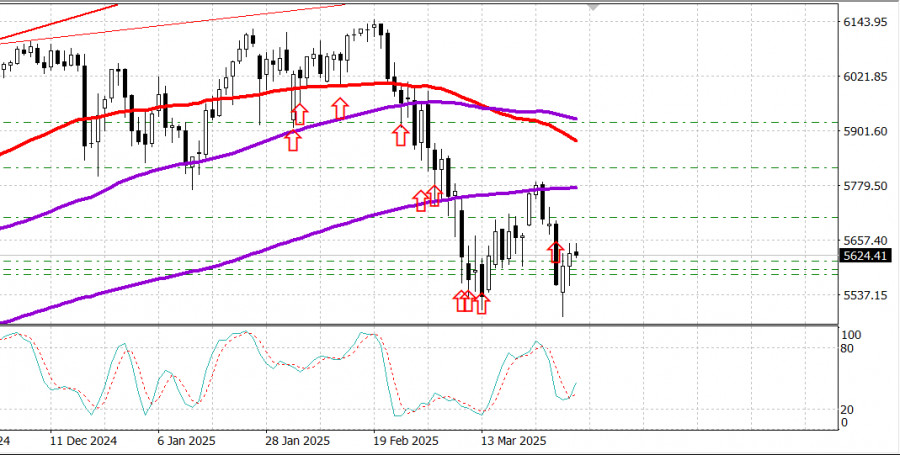MobileTrader
MobileTrader: trading platform near at hand!
Download and start right now!

 02.04.2025 12:15 PM
02.04.2025 12:15 PMS&P 500
The US stock markets paused ahead of President Trump's anticipated tariff announcements.
The major indices ended the session mixed: the Dow Jones closed flat, the Nasdaq gained 0.9%, and the S&P 500 rose 0.4%, trading within a 5,500–6,000 range and closing near 5,633 points.
The stock market opened the second quarter on an uncertain note. Key indices fluctuated around their previous closing levels as investors awaited today's tariff announcement while digesting early macroeconomic data.
Markets initially declined after the opening bell, with selling pressure increasing following the release of the ISM Manufacturing PMI, which came in at 49.0 points, below the consensus estimate of 49.8 points and down from the previous 50.3-point reading. The report indicated a contraction in manufacturing activity in March, coupled with a sharp rise in prices for the second consecutive month.
The data added to growing market fears about economic slowdown and profit margin pressure, which were already amplified by trade-related uncertainty.
However, intraday buying in megacap stocks helped lift the broader market. Apple (AAPL $223.19, +$1.06, +0.5%), Microsoft (MSFT $382.19, +$6.80, +1.8%), and NVIDIA (NVDA $110.15, +$1.77, +1.6%)—together accounting for nearly 20 percent of the S&P 500 by market cap—were among the session's top contributors.
Eight of the 11 sectors in the S&P 500 posted gains, led by consumer discretionary (+1.1%), communication services (+1.0%), and technology (+1.0%). Healthcare (-1.8%) and financials (-0.2%) were the only sectors to close lower.
US Treasuries finished stronger across the curve. The yield on the 10-year note fell by nine basis points to 4.16%, while the 2-year yield dropped five basis points to 3.86 percent.
Year-to-date index performance:
Dow Jones Industrial Average: -1.3%
S&P 500: -4.2%
S&P Midcap 400: -5.9%
Russell 2000: -9.8%
Nasdaq Composite: -9.6%
Economic data highlights:
S&P Global US Manufacturing PMI (March, Final): 50.2 points (previous 49.8 points)
ISM Manufacturing PMI (March): 49.0 points (consensus 49.8 points; previous 50.3 points)
The report points to a troubling mix of slowing activity, rising prices, and weakening employment, a combination likely to spark stagflation concerns.
JOLTS Job Openings (February): 7.568 million (previous reading was revised up to 7.762 million)
Construction Spending (February): +0.7% (consensus +0.4%; previous revised to -0.5% from -0.2%)
The weakness in private housing investment was concentrated in the multifamily segment.
On Wednesday, traders may get the following data:
7:00 AM ET: Weekly MBA Mortgage Applications (previous -2.0%)
8:15 AM ET: ADP Employment Change (March, consensus: 120,000; previous: 77,000)
10:00 AM ET: Factory Orders (February, consensus: +0.4%; previous: +1.7%)
10:30 AM ET: Weekly Crude Oil Inventories (previous: -3.34 million barrels)
Energy Markets: Brent crude held steady at $74.30 per barrel. Despite signs of US economic deceleration, oil prices remained supported by geopolitical tension following President Trump's threats to strike Iran if it refuses to rejoin a nuclear agreement. Tehran has effectively declined to resume negotiations.
Conclusion: A rebound in US equities remains a possible scenario, particularly if the details of Trump's new tariff package bring greater clarity. Current price levels may offer attractive long-term entry points in the S&P 500 for investors willing to position ahead of policy resolution.
Additional insights by Mikhail Makarov:
https://www.instaforthtex.com/ru/forex_analysis/?x=mmakarov
https://www.instafxtrends.com/ru/forex_analysis/?x=mmakarov
MobileTrader: trading platform near at hand!
Download and start right now!
You have already liked this post today
*Disclaimer: The market analysis posted here is meant to increase your awareness, but not to give instructions to make a trade.
 If you have any content questions, please contact editorial-board@instaforex.com
If you have any content questions, please contact editorial-board@instaforex.com






